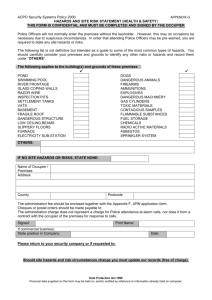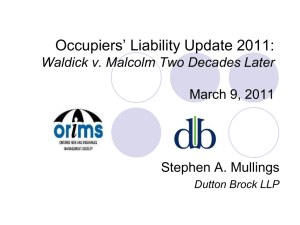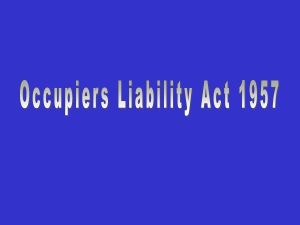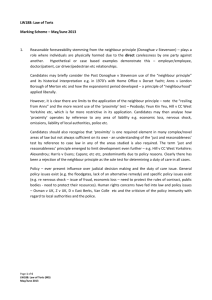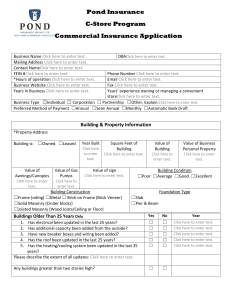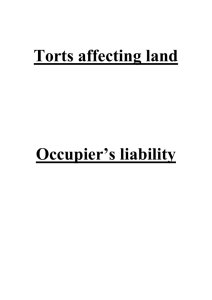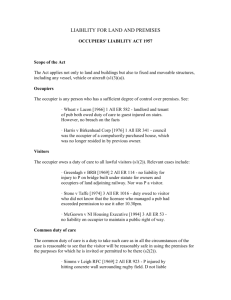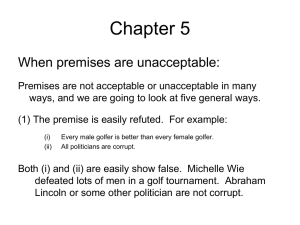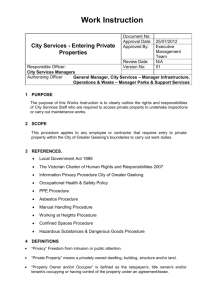12_-_occupier_s_liability
advertisement
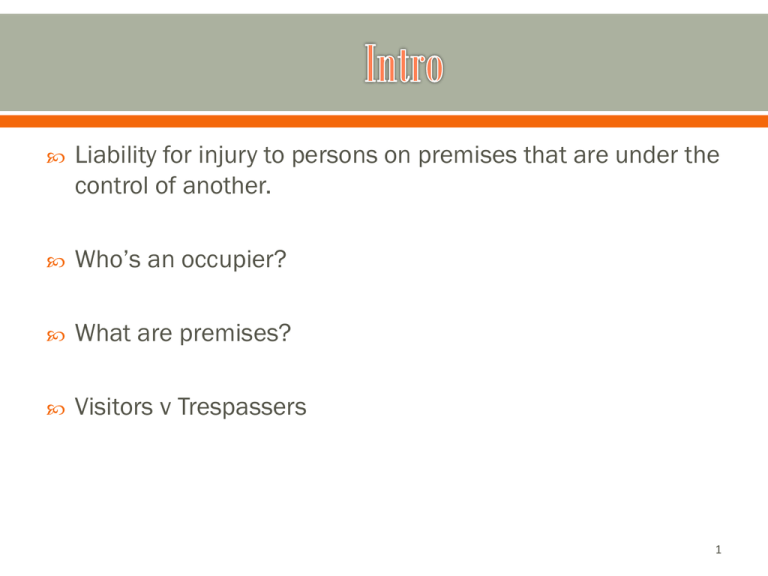
Liability for injury to persons on premises that are under the control of another. Who’s an occupier? What are premises? Visitors v Trespassers 1 Wheat v Lacon (1966) Exercises a sufficient degree of control over the premises Lord Denning identified 4 categories of Occupiers: 1. If the landlord rents the premises to a tenant, then the tenant is the occupier. 2. If the landlord rents the premises, he remains liable for common areas such as stairs, gardens etc. 3. If the landlord grants a licence, then both are occupiers. 4. If the landlord engages an independent contractor, then the landlord remains the occupier BUT the independent contractor may be the occupier if he has a high level of control. 2 “… any fixed or moveable structure, including any vessel, vehicle or aircraft.” Obviously land, buildings and houses, but what about… Ladders? – Wheeler v Copas [1981] Ships in dry dock? - London Graving Dock v Horton (1951) Vehicles? - Hartwell v Grayson (1947) Lifts? - Haseldine v Daw & Son Ltd (1941) 3 Occupiers must keep premises in a reasonably safe condition. There must be “negligence”, “defect” or “danger” with the premises for claim to succeed. If someone tries to run up the sides of the Hall of Justice and falls, will their claim be successful? Maloney v Torfean CBC (2005, CA) 4 Anyone with expressed or implied permission to be on the property. Includes permission granted by law: Police Officers. Health Inspectors? Jehovah’s Witnesses? Political Canvassers? Robson v. Hallet (1967) “...when a householder lives in a dwelling house to which there is a garden in front and does not lock the gate of the garden it gives an implied licence to any member of the public who has lawful reason for doing so to proceed from the gate to the front door or the back door...” Person taking a short-cut? Lowery v Walker [1911] 5 1. Warning – Sufficient to enable the visitor to be reasonably safe o 2. Lewis v Ronald (1909) Lewis was delivering fish at an apartment-house, when he fell down an unlighted stairway. Ronald entered into an agreement with the tenants that he would light the staircases on the premises "when necessary." Deliberate – Goes into area known to be “out of bounds” o Anderson v Coutts (1894) Anderson fell over a cliff after he ignored a warning notice and climbed over railings. 6 3. Overstay o 4. Stone v Taffe (1974) Drinking after 10:30pm was not allowed, but this was never communicated to the patron, so bar owner was still liable. Had the patron been notified, he would have lost his visitor status. Alien o The Calgarth 1927 Scrutton LJ: “When you invite a person into your house to use the staircase, you do not invite him to slide down the banisters. 7 Addie v Dumbreck [1929] The defendant owned a coal mine, which had a fence around the perimeter of the field although there were large gaps in it. The field was frequently used as a short cut to a railway station and children would use it as a playground. The defendant would often warn people off the land but the attempts were not effective and no real attempt was made to ensure that people did not come onto the land. A child came on to the land and was killed when he climbed onto a piece of haulage apparatus. Held: No duty of care was owed to trespassers to ensure that they were safe when coming onto the land. The only duty was not to inflict harm wilfully. 8 British Railways Board v. Herrington (1972) Herrington, a child, had gone through a fence onto the railway line, and been badly injured. The Board knew of the broken fence, but argued that they owed no duty to a trespasser. 9 The defendants burgled the home of one of the defendants, where he lived with his parents and stole two television sets Burglary involves entry onto property as a trespasser, so they tried to argue that they were visitors. Held: The appellants had exceeded their permission by stealing and were thus trespassers. 10 Must be prepared for children to be less careful than adults Pearson v Coleman Bros [1948] 7 year old girl went to the circus with her family. She wandered off to go to the toilets instead she ended up in the animal enclosure and was attacked by a lion. Parental Responsibility for young children Phipps v Rochester Corporation [1955] 5 year old boy supervised by his sister aged 7 fell into a trench dug by Rochester Corp for the purpose of laying down sewers 11 Anything that entices a child Glasglow Corporation v Taylor (1922) Eight year old boy ate poisonous berries in park and died. There was no fence or warning signs. 12 Occupier is not liable for hazards arising from the work. (e.g. The occupier is not liable if an electrician electrocutes himself) Roles v Nathan [1963] Two chimney sweeps were sealing up a sweep hole in a flue (chimney opening). Carbon monoxide came through. They had been warned repeatedly, and told not to stay in too long, and not to work while a fire was alight. Once already, they had been dragged out for not doing as they were told. They died while working when the fire was burning. The widows sued the occupier. Held: The defendant was not liable. The dangers were special risks ordinarily incident to their calling. The warnings issued were clear and the brothers would have been safe had they heeded the warnings. 13

